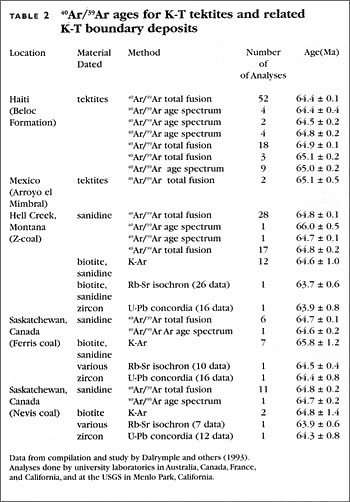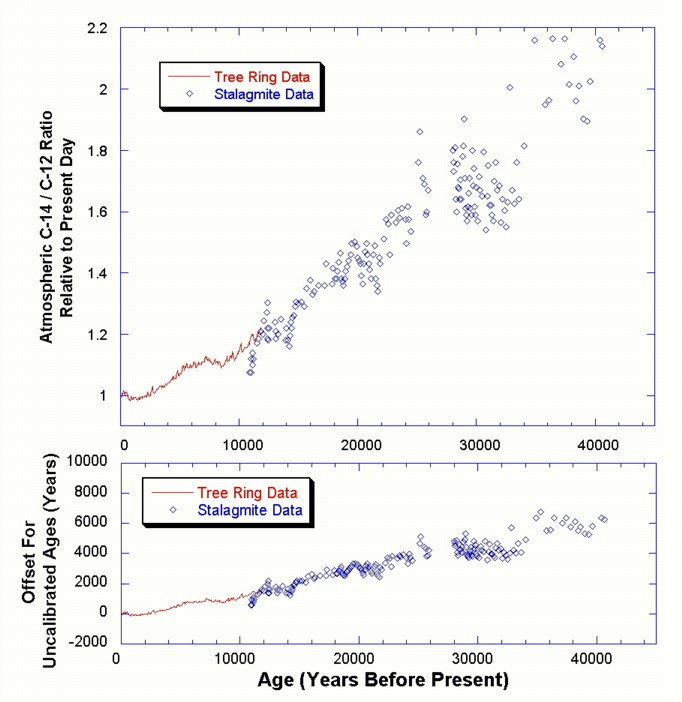Note that this assumption implies a thorough mixing and melting of the magma, which would also mix in the parent substances as well. Then we require some process to preferentially concentrate the parent substances in certain places. Radioactive decay would generate a concentration of D proportional to P. By taking enough measurements of the concentrations of P, D, and N, we can solve for c1 and c2, and from c1 we can determine the radiometric age of the sample.
Otherwise, the system is degenerate. Thus we need to have an uneven distribution of D relative to N at the start. If these ratios are observed to obey such a linear relationship in a series of rocks, then an age can be computed from them. The bigger c1 is, the older the rock is. That is, the more daughter product relative to parent product, the greater the age. Thus we have the same general situation as with simiple parent-to-daughter computations, more daughter product implies an older age. This is a very clever idea.
However, there are some problems with it. First, in order to have a meaningful isochron, it is necessary to have an unusual chain of events.
Radiometric dating
Initially, one has to have a uniform ratio of lead isotopes in the magma. Usually the concentration of uranium and thorium varies in different places in rock. This will, over the assumed millions of years, produce uneven concentrations of lead isotopes. To even this out, one has to have a thorough mixing of the magma. Even this is problematical, unless the magma is very hot, and no external material enters. Now, after the magma is thoroughly mixed, the uranium and thorium will also be thoroughly mixed. What has to happen next to get an isochron is that the uranium or thorium has to concentrate relative to the lead isotopes, more in some places than others.
So this implies some kind of chemical fractionation. Then the system has to remain closed for a long time. This chemical fractionation will most likely arise by some minerals incorporating more or less uranium or thorium relative to lead. Anyway, to me it seems unlikely that this chain of events would occur. Another problem with isochrons is that they can occur by mixing and other processes that result in isochrons yielding meaningless ages. Sometimes, according to Faure, what seems to be an isochron is actually a mixing line, a leftover from differentiation in the magma.
Fractionation followed by mixing can create isochrons giving too old ages, without any fractionation of daughter isotopes taking place. To get an isochron with a false age, all you need is 1 too much daughter element, due to some kind of fractionation and 2 mixing of this with something else that fractionated differently. Since fractionation and mixing are so common, we should expect to find isochrons often. How they correlate with the expected ages of their geologic period is an interesting question. There are at least some outstanding anomalies. Faure states that chemical fractionation produces "fictitious isochrons whose slopes have no time significance.
As an example, he uses Pliocene to Recent lava flows and from lava flows in historical times to illustrate the problem.
- list of all the dating site in the world.
- .
- ?
He says, these flows should have slopes approaching zero less than 1 million years , but they instead appear to be much older million years. Steve Austin has found lava rocks on the Uinkeret Plateau at Grand Canyon with fictitious isochrons dating at 1. Then a mixing of A and B will have the same fixed concentration of N everywhere, but the amount of D will be proportional to the amount of P.
- ?
- ;
- free dating software open source.
- dating sites dubai free.
- gay dating kumbakonam.
- More Bad News for Radiometric Dating.
This produces an isochron yielding the same age as sample A. This is a reasonable scenario, since N is a non-radiogenic isotope not produced by decay such as lead , and it can be assumed to have similar concentrations in many magmas. Magma from the ocean floor has little U and little U and probably little lead byproducts lead and lead Magma from melted continental material probably has more of both U and U and lead and lead Thus we can get an isochron by mixing, that has the age of the younger-looking continental crust.
The age will not even depend on how much crust is incorporated, as long as it is non-zero. However, if the crust is enriched in lead or impoverished in uranium before the mixing, then the age of the isochron will be increased. If the reverse happens before mixing, the age of the isochron will be decreased. Any process that enriches or impoverishes part of the magma in lead or uranium before such a mixing will have a similar effect. So all of the scenarios given before can also yield spurious isochrons.
I hope that this discussion will dispel the idea that there is something magical about isochrons that prevents spurious dates from being obtained by enrichment or depletion of parent or daughter elements as one would expect by common sense reasoning. So all the mechanisms mentioned earlier are capable of producing isochrons with ages that are too old, or that decrease rapidly with time. The conclusion is the same, radiometric dating is in trouble. I now describe this mixing in more detail. Suppose P p is the concentration of parent at a point p in a rock.
The point p specifies x,y, and z co-ordinates. Let D p be the concentration of daughter at the point p. Let N p be the concentration of some non-radiogenic not generated by radioactive decay isotope of D at point p. Suppose this rock is obtained by mixing of two other rocks, A and B. Suppose that A has a for the sake of argument, uniform concentration of P1 of parent, D1 of daughter, and N1 of non-radiogenic isotope of the daughter.
- Radiometric dating - Wikipedia;
- How reliable is geologic dating?.
- !
- ;
- .
Thus P1, D1, and N1 are numbers between 0 and 1 whose sum adds to less than 1. Suppose B has concentrations P2, D2, and N2.
Let r p be the fraction of A at any given point p in the mixture. So the usual methods for augmenting and depleting parent and daughter substances still work to influence the age of this isochron. More daughter product means an older age, and less daughter product relative to parent means a younger age. In fact, more is true. Any isochron whatever with a positive age and a constant concentration of N can be constructed by such a mixing. It is only necessary to choose r p and P1, N1, and N2 so as to make P p and D p agree with the observed values, and there is enough freedom to do this.
Anyway, to sum up, there are many processes that can produce a rock or magma A having a spurious parent-to-daughter ratio. Then from mixing, one can produce an isochron having a spurious age. This shows that computed radiometric ages, even isochrons, do not have any necessary relation to true geologic ages. Mixing can produce isochrons giving false ages. But anyway, let's suppose we only consider isochrons for which mixing cannot be detected.
How do their ages agree with the assumed ages of their geologic periods? As far as I know, it's anyone's guess, but I'd appreciate more information on this.
Navigation menu
I believe that the same considerations apply to concordia and discordia, but am not as familiar with them. It's interesting that isochrons depend on chemical fractionation for their validity. They assume that initially the magma was well mixed to assure an even concentration of lead isotopes, but that uranium or thorium were unevenly distributed initially.
So this assumes at the start that chemical fractionation is operating. But these same chemical fractionation processes call radiometric dating into question. The relative concentrations of lead isotopes are measured in the vicinity of a rock. The amount of radiogenic lead is measured by seeing how the lead in the rock differs in isotope composition from the lead around the rock. This is actually a good argument. But, is this test always done? How often is it done?

And what does one mean by the vicinity of the rock? How big is a vicinity? One could say that some of the radiogenic lead has diffused into neighboring rocks, too. Some of the neighboring rocks may have uranium and thorium as well although this can be factored in in an isochron-type manner.
UCSB Science Line
Furthermore, I believe that mixing can also invalidate this test, since it is essentially an isochron. Finally, if one only considers U-Pb and Th-Pb dates for which this test is done, and for which mixing cannot be detected. The above two-source mixing scenario is limited, because it can only produce isochrons having a fixed concentration of N p.
To produce isochrons having a variable N p , a mixing of three sources would suffice. This could produce an arbitrary isochron, so this mixing could not be detected. Also, it seems unrealistic to say that a geologist would discard any isochron with a constant value of N p , as it seems to be a very natural condition at least for whole rock isochrons , and not necessarily to indicate mixing. I now show that the mixing of three sources can produce an isochron that could not be detected by the mixing test.
First let me note that there is a lot more going on than just mixing.
